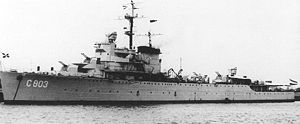HNLMS Jacob van Heemskerk
 |
|
| History | |
|---|---|
|
|
|
| Name: | Jacob van Heemskerck |
| Namesake: | Jacob van Heemskerk |
| Builder: | Nederlandsche Scheepsbouw Mij., Amsterdam; completed in British yard |
| Laid down: | 31 October 1938 |
| Launched: | 16 September 1939 |
| Completed: | 10 May 1940 |
| Commissioned: | 16 September 1939 |
| Decommissioned: | 20 November 1969 |
| Struck: | 27 February 1970 |
| Fate: | Sold for scrap, 23 June 1970 |
| General characteristics | |
| Class and type: | Tromp-class light cruiser |
| Displacement: | 4,000 long tons (4,064 t) standard |
| Length: | 131.95 m (432 ft 11 in) |
| Beam: | 12.4 m (40 ft 8 in) |
| Draught: | 4.8 m (15 ft 9 in) |
| Propulsion: |
|
| Speed: | 32.5 knots (37.4 mph; 60.2 km/h) |
| Complement: | 393 or 420 |
| Armament: |
|
| Armour: |
|
HNLMS Jacob van Heemskerck (Dutch: Hr.Ms. Jacob van Heemskerck) was a Tromp-class light cruiser of the Royal Netherlands Navy, named after Admiral Jacob van Heemskerk (1567–1607).
Originally designated as a flotilla leader and a torpedo cruiser in Decker's Fleet Plan of 1931, she was hastily commissioned on 10 May 1940, when Germany invaded the Netherlands. However, as she was not armed she escaped to the United Kingdom, where she was refitted as an air defence cruiser, since these were the only type of gun available, and there was a growing need for this type of ship to protect the convoys. During the Second World War the crew felt that their ship was blessed and gave her the nickname Oude Jacob (Old Jacob). She received the reputation that not a single convoy ship would be lost when she was on duty.
The ship was meant to commence trials on the day the Germans invaded and to prevent her capture was immediately pressed into service. Since she had no armament she left port for the United Kingdom with only a skeleton crew. Once she had arrived in Portsmouth attempts were made to give her weaponry of some sort. She received depth charge equipment from the old torpedo boats G13 and G15. On 18 May 1940, Queen Wilhelmina paid the ship a visit. At the end of the month, Heemskerck and the cruiser HNLMS Sumatra received the assignment to transport Princess Juliana and her two children (including the later Beatrix of the Netherlands) to Canada. The ships put to sea on 2 June and arrived on 11 June at Halifax.
Heemskerck returned alone to England and arrived at Portsmouth in July where her re-arming program began. The British Admiralty decided to convert her to an anti-aircraft ship. Work was completed on 17 February 1941, and after sea trials, which lasted till 29 February, the ship was assigned as convoy escort in the Atlantic Ocean as part of the Irish Sea Escort.
...
Wikipedia
